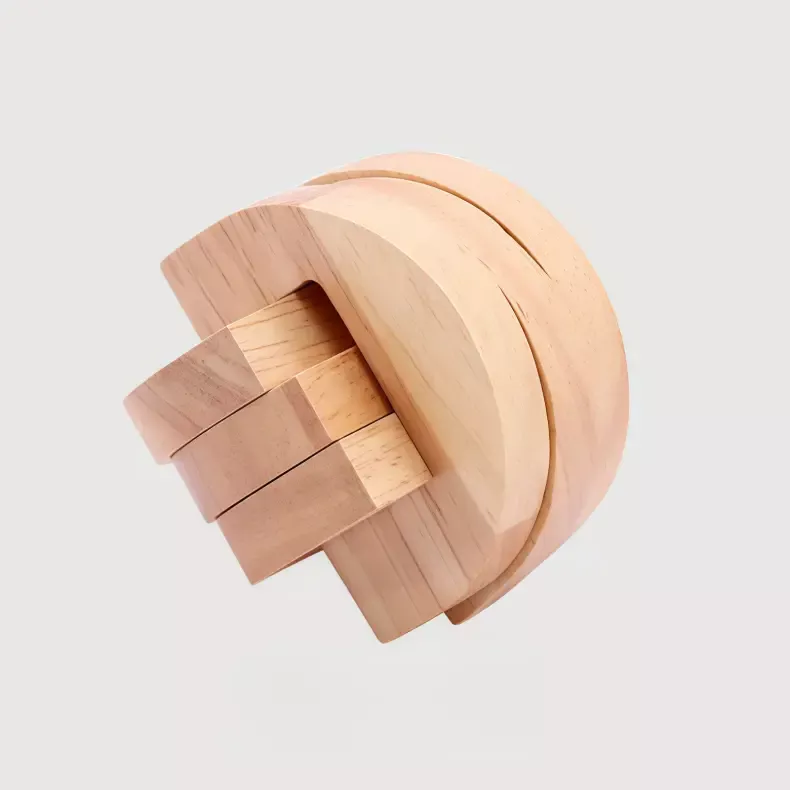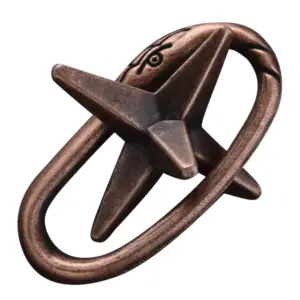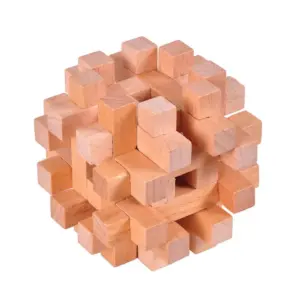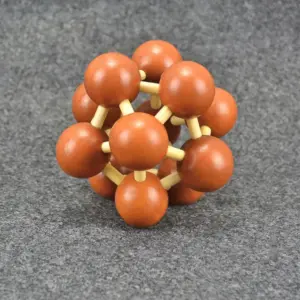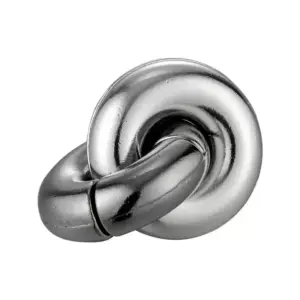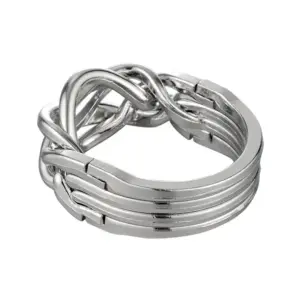I’ve been collecting and reviewing wooden mechanical puzzles for over fifteen years, and the Interlock Puzzle Sphere remains one of those designs that separates casual solvers from serious puzzle enthusiasts. If you’re staring at six D-shaped wooden pieces wondering how they could possibly form a perfect sphere, you’re exactly where I was the first time I encountered this beauty. Let me save you some frustration.
What Makes the Interlock Puzzle Sphere Different
Unlike mass-produced puzzle spheres that rely on obvious interlocking mechanisms, this six-piece design operates on a principle that’s deceptively elegant. Each piece is a semi-circular wooden arc—think of the letter “D” bent into a ring—with a square notch cut into its center. The genius lies in the subtle variations. Only two pieces are truly identical; the remaining four each have unique internal geometries that determine exactly how they lock together.
The Interlock Puzzle Sphere doesn’t use magnets, hidden hinges, or trick mechanisms. It’s pure geometry. When assembled correctly, the pieces create a seamless sphere with no visible gaps. When assembled incorrectly—which you’ll do many times before getting it right—they simply won’t close. The puzzle is honest that way. It doesn’t pretend to work when it doesn’t.
Interlock Puzzle Sphere
- Six unique wooden pieces form a seamless sphere through precision interlocking—disassembles in seconds once you find the key piece, but reassembly demands the kind of patient, ego-free problem-solving that ancient wisdom traditions celebrated: meeting each piece where it is rather than forcing where you want it to be.
- Premium wooden construction with smooth, satisfying tactile feedback that transforms this Interlock Puzzle Sphere from mere brain teaser into meditative practice—each attempt teaches you to recognize patterns, trust the process, and embrace the philosophy that true mastery comes from adapting to the puzzle’s nature rather than imposing your will upon it.
The Disassembly Secret Everyone Misses
Here’s what nobody tells you about taking apart an Interlock Puzzle Sphere: there’s one key piece that makes the whole thing possible, and if you don’t find it, you’ll spend ten minutes trying to pry apart pieces that have no intention of separating.
Hold the assembled sphere and examine the bottom edge of each arc. You’re looking for the piece whose “foot”—that little protruding section at the base—has the slightest give when you press it sideways. Found it? That’s your key piece. Gently push it horizontally, and it’ll slide out of the grooves holding it captive. The moment that piece clears, the entire structure loosens.
From there, the remaining five pieces separate along their natural seam lines. No forcing required. Lay all six pieces flat on your table with their notches facing up. You’re ready to attempt assembly, which is where things get interesting.
The Assembly Sequence: Step-by-Step Breakdown
I’m going to walk you through this exactly as it appears in the solution video that’s helped thousands of frustrated puzzle owners. Bookmark this page—you’ll reference it multiple times before the sequence sticks in your memory.
Phase One: Creating the Foundation (0:17-0:22)
Grab two pieces with obvious notches. Place the first one with its notch pointing right. Take the second piece, rotate it so its notch points left, and overlap them in the middle section. The notches should align to form a cross-shape when viewed from above. This foundation is critical—if these two pieces aren’t properly seated, nothing else will fit correctly later.
Phase Two: Introducing the Core Pieces (0:23-0:31)
Now you need one of the two identical pieces—the ones where the notch isn’t immediately obvious because it’s positioned on the interior curve. Hold it vertically above your foundation and insert it straight down into the gap between your first two pieces. Once it’s seated, slide it to the left until it clicks into the groove.
Grab the second identical piece and repeat from the right side. Slide it leftward into position. At this point, you should see the bottom edges of your lower pieces aligning. If they’re not flush, something went in wrong—back up and recheck the orientation of each piece.
Phase Three: Adding the Lateral Support (0:32-0:41)
You’re looking for the C-shaped piece now—the one where the notch sits at the top of the arc rather than dead center. Slide it into the structure from one side. It should slip in smoothly if everything before it was correct. Push the middle pieces forward slightly to tighten the entire assembly, then rotate the partial sphere back to your starting orientation. This rotation is easy to forget but essential for accessing the correct insertion angle for the final piece.
Phase Four: The Final Lock (0:42-0:53)
Last piece. This one enters from below, pushing upward through the corresponding gap in your nearly complete sphere. The video shows this clearly around the 0:44 mark—angle it carefully so the notch threads through the existing structure. You’ll need to make micro-adjustments here, shifting the piece slightly until it seats properly.
Here’s the moment that trips people up: remember those middle pieces you pushed forward earlier? Push them back home. They should slide into their final locked position with a satisfying resistance. When every piece is fully seated, you’ll have a complete Interlock Puzzle Sphere with no gaps and no wobble.
@teasipcom Solving the “Impossible” Interlocking Puzzle Sphere! 👀 ♬ original sound – Tea-sip
Why This Puzzle Frustrates (And Why That’s Good)
I get emails from customers who’ve given up on their Interlock Puzzle Sphere after an hour. I also get emails from customers who’ve solved it seventeen times and still find it meditative. The difference isn’t intelligence—it’s approach.
This puzzle punishes forcing. If a piece isn’t sliding in smoothly, you’re either using the wrong piece or inserting from the wrong angle. The wood will show scratches and pressure marks if you try to muscle through the solution. The correct sequence requires almost no force at all. That’s intentional. The puzzle is teaching you to observe rather than dominate.
There’s a reason the product description references ancient philosophy about meeting things where they are. The Interlock Puzzle Sphere makes you slow down, pay attention to each piece’s unique geometry, and trust the process. In an age where we’re used to forcing our way through problems with brute effort or Google searches, a puzzle that demands patience feels almost radical.
Common Mistakes and How to Avoid Them
After watching dozens of people attempt this puzzle, I’ve noticed the same errors repeatedly:
Mixing up the identical pieces. Yes, two pieces are the same, but they’re also easy to confuse with the C-shaped piece if you’re not paying attention. Hold all three side-by-side and note the notch positions before you start assembling.
Skipping the rotation step. Around timestamp 0:39 in the solution video, there’s a deliberate rotation of the partial sphere. People skip this, try to jam the final piece in from the wrong angle, and wonder why it won’t fit. Orientation matters enormously.
Forgetting to push the core pieces back. The middle pieces get pushed forward during assembly to make room for the lateral piece. If you don’t push them back at the end, the sphere won’t fully close. This is the number one reason people think they’ve “almost” solved it but can’t get those last pieces to seat.
Quality Considerations: What to Expect
Not all Interlock Puzzle Spheres are created equal, and after handling versions from multiple manufacturers, the differences are significant. Look for smooth, splinter-free edges—your fingers will thank you during extended solving sessions. The wood should be finished but not overly polished; a slight natural texture helps with grip.
Check the tolerances. Pieces should fit together snugly without gaps, but they shouldn’t require excessive force. If you’re receiving one as a gift or purchasing online, reviews mentioning “smooth assembly” and “precise cuts” are good indicators. Complaints about pieces that stick or won’t slide properly usually point to manufacturing inconsistencies.
Size matters more than you’d think. Some versions are barely larger than a tennis ball, while others approach softball dimensions. The smaller versions are portable and charming but can be genuinely difficult to manipulate if you have larger hands. Check the specifications before ordering.
Is the Interlock Puzzle Sphere Worth Your Time?
Let me be direct: this puzzle isn’t for everyone. If you’re buying it as a casual coffee table decoration that guests might fiddle with for thirty seconds, you’re better off with something simpler. The Interlock Puzzle Sphere demands commitment. It’s for people who enjoy the process of solving, not just the satisfaction of completion.
That said, for the right person, this puzzle delivers something increasingly rare: an analog challenge that requires genuine problem-solving without any digital assistance. No app can solve this for you. No tutorial can move your hands. You have to sit with it, experiment, fail, and gradually understand the logic governing its assembly.
The replayability is honestly limited. Once the sequence is in your muscle memory—usually after three to five complete solutions—the challenge diminishes significantly. But there’s value in that too. It becomes a meditative practice, a brief mental reset you can perform while waiting for coffee to brew or winding down before bed.
Where the Interlock Puzzle Sphere Fits in Your Collection
In the hierarchy of wooden mechanical puzzles, this sits comfortably in the intermediate-to-advanced range. It’s more challenging than basic burr puzzles but less sadistic than some of the impossible-looking designs by craftsmen like Stewart Coffin or Jerry McFarland. If you’ve successfully solved a standard six-piece burr and are ready to level up, the Interlock Puzzle Sphere is a logical next step.
It also makes an exceptional gift for the right recipient. I’ve seen it work beautifully for engineers, architects, and anyone who works with spatial reasoning professionally. It’s less successful as a gift for people who enjoy puzzles casually—they’ll attempt it once, get frustrated, and shelve it permanently.
Final Thoughts from Someone Who’s Solved It Too Many Times
The Interlock Puzzle Sphere has stayed relevant in a market flooded with gimmicky puzzle toys because it does one thing exceptionally well: it makes you think spatially without being deliberately obscure. There’s a solution logic that makes sense once you see it, but discovering that logic requires patience and attention.
If you’ve purchased one and you’re stuck, use the video guide linked earlier in this article. Don’t feel bad about needing help—this puzzle has humbled people far more experienced than you. And once you’ve solved it successfully, try it again in a week without referencing any guides. You’ll be surprised how much the process cements itself in your memory.
The best puzzles teach you something beyond their own solution. The Interlock Puzzle Sphere teaches you to slow down, observe carefully, and trust that the answer exists even when it’s not immediately obvious. In 2025, when everything moves at algorithm speed, a puzzle that forces you to think at wood speed feels almost countercultural. And that might be exactly what makes it valuable.
Questions about your Interlock Puzzle Sphere? Drop a comment below or check out our full collection of mechanical brain teasers.


